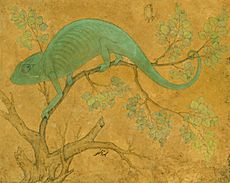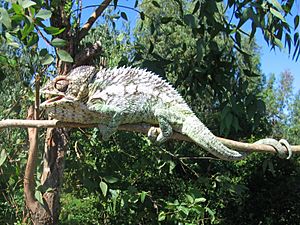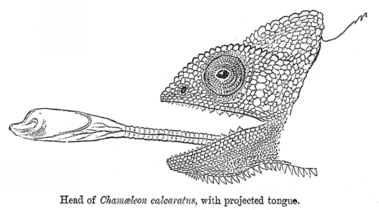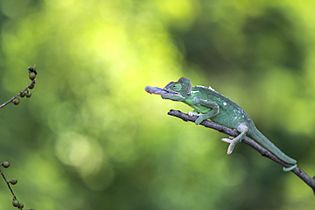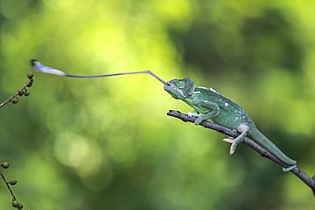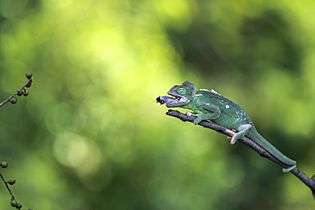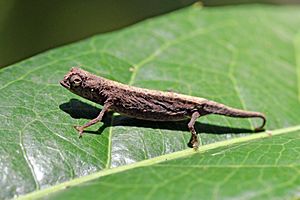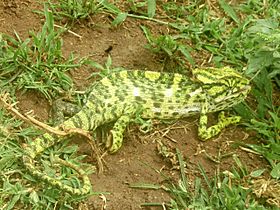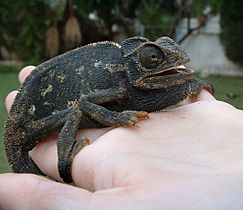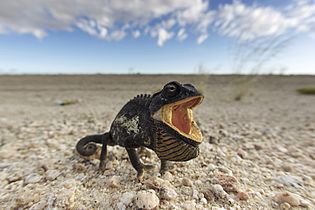Chameleon facts for kids
Quick facts for kids Chameleons |
|
|---|---|
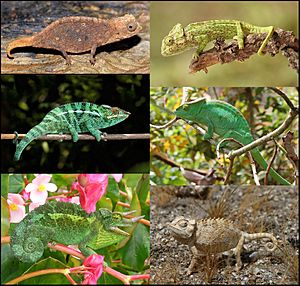 |
|
| Chamaeleonidae | |
| Scientific classification |
|
| Kingdom: | Animalia |
| Phylum: | Chordata |
| Class: | Reptilia |
| Order: | Squamata |
| Suborder: | Iguania |
| Clade: | Acrodonta |
| Family: | Chamaeleonidae Rafinesque, 1815 |
| Genera | |
|
|
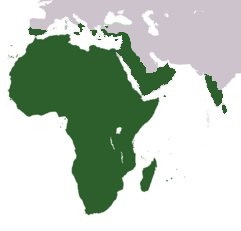 |
|
| Native range of Chamaeleonidae | |
Chameleons are a special group of lizards. There are over 200 different kinds of chameleons. They are famous for their amazing ability to change their skin color. Chameleons are great climbers and hunters.
They live in warm places like rainforests and deserts. You can find them in Africa, Madagascar, southern Europe, and parts of Asia. Some chameleons have also been brought to places like Hawaii and Florida.
Contents
What's in a Name?
The word chameleon comes from old languages. It comes from the Greek words khamai (meaning "on the ground") and léōn (meaning "lion"). So, it's like a "ground lion"!
How Chameleons Change Color
Chameleons can change their skin color in many ways. They can show colors like pink, blue, red, orange, green, black, and more.
Their skin has special cells with tiny crystals. These crystals can change how light reflects off them. This is how chameleons shift their colors.
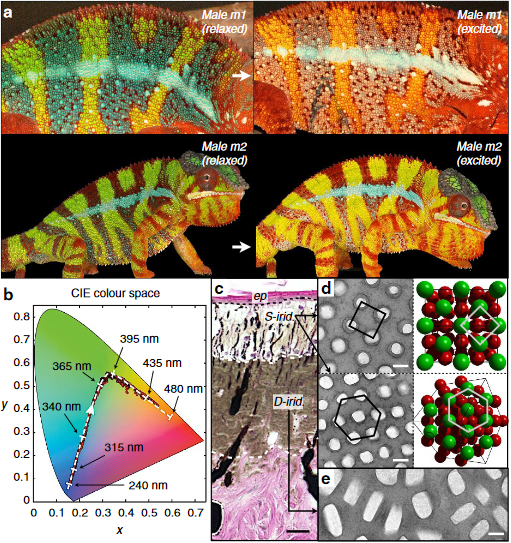
Chameleons change color for a few reasons. One reason is to blend in with their surroundings. But mostly, they change color to talk to other chameleons. They also change color to control their body temperature.
- To get warm: They turn darker to soak up more sunlight and heat.
- To cool down: They turn lighter to reflect light and stay cool.
- To show feelings: Chameleons get brighter when they are angry. They turn darker when they want to give up.
Some chameleons, like Smith's dwarf chameleon, even change colors to hide from specific predators, like birds or snakes. Chameleons in forests often have brighter colors. Those in deserts might have more brown or gray colors.
Chameleon History
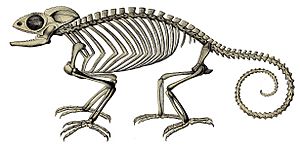
The oldest chameleon fossil found is Anqingosaurus brevicephalus. It lived about 58 to 61 million years ago in China.
Chameleons likely came from mainland Africa. From there, they traveled across the ocean to places like Madagascar. Today, almost half of all chameleon species live in Madagascar.
What Chameleons Look Like
Chameleons come in many sizes. Some are tiny, like the male Brookesia micra, which is only about 1.5 cm long. Others are very big, like the male Furcifer oustaleti, which can be over 68 cm long.
Many chameleons have cool decorations on their heads. Some have horns, like Trioceros jacksonii. Others have big crests, like Chamaeleo calyptratus. Male chameleons usually have more decorations than females.
Here are some common chameleon species and their sizes:
| Scientific name | Common name | Length (male) | Length (female) | Color | Lifespan (years) |
|---|---|---|---|---|---|
| Chamaeleo calyptratus | Veiled chameleon | 35–60 cm | 25–33 cm | Green and light colors | about 5 |
| Trioceros jacksonii | Jackson's chameleon | 23–33 cm | 25–33 cm | Green and light colors | 5–10 |
| Furcifer pardalis | Panther chameleon | 38–53 cm | 23–33 cm | Darker colors | about 5 (2–3 for birthing females) |
| Rieppeleon brevicaudatus | Bearded pygmy chameleon | 5–8 cm | 5–8 cm | Brown, beige, green | about 3–5 |
| Rhampholeon spectrum | Spectral pygmy chameleon | 8–10 cm | 5–10 cm | Tan and gray | 3–5 |
| Rhampholeon temporalis | Usambara pitted pygmy chameleon | 6–10 cm | 5–9 cm | Gray and brown | 5–11 |
Chameleons have special feet for climbing trees. Their five toes on each foot are grouped like tongs. This helps them grip branches very tightly. Each toe also has a sharp claw for extra grip.
Some chameleons have small spikes along their backs. These spikes help them blend in by breaking up their body shape.
Amazing Senses
Chameleons have very unique eyes. Their upper and lower eyelids are joined, with only a small hole for the pupil. Each eye can move and focus on its own. This means a chameleon can look at two different things at the same time! They can see all around their bodies.
Chameleons don't have outer ears or eardrums. But they can still hear some sounds, especially low-pitched ones. They can also see both regular light and ultraviolet light. UV light helps them feel good and encourages them to bask, eat, and reproduce.
How Chameleons Eat
All chameleons mainly eat insects. They catch their prey by shooting out their long tongues. A chameleon's tongue can be one and a half to two times longer than its body! Smaller chameleons can even shoot their tongues out more than twice their body length.
Their tongues are super fast. They can reach prey in less than a tenth of a second. This is faster than a blink of an eye! The tongue sticks to the prey, and then the chameleon pulls it back into its mouth.
- Use of tongue in feeding
Glowing Bones
Some chameleons have bones that glow under ultraviolet light. This is called biogenic fluorescence. Scientists found this in 31 species of Calumma chameleons from Madagascar. Their bones glow a bright blue, and the glow can even shine through their skin. This glow might be a secret way for chameleons to signal each other.
Where Chameleons Live
Chameleons mostly live in Africa and Madagascar. Some species also live in southern Europe, the Middle East, India, and Sri Lanka.
They live in many different places. These include rainforests, savannas, and even deserts. Most chameleons live in trees or bushes. But some, like the Namaqua chameleon, live mostly on the ground. Many chameleon species are in danger of extinction because their homes are being destroyed.
Chameleon Babies
Most chameleons lay eggs. The female digs a hole, usually 10 to 30 cm deep. Then she lays her eggs. The number of eggs can vary a lot. Small species might lay only 2 to 4 eggs. Large species, like the veiled chameleon, can lay 20 to 200 eggs!
The eggs usually hatch after 4 to 12 months. Some, like the Parson's chameleon, can take over two years to hatch.
Some chameleons, like the Jackson's chameleon, give birth to live young. The babies are born inside a sticky clear sac. The mother presses each sac onto a branch. The sac then bursts, and the baby chameleon climbs out. A female can have up to 30 live babies at once.
What Chameleons Eat
Chameleons mostly eat insects. But larger species might also eat other small lizards or young birds.
Here are some examples of what different chameleons eat:
- The veiled chameleon from Arabia eats insects. If there's no water, they might eat leaves to get moisture. They can eat many crickets in a day.
- Jackson's chameleon from Kenya eats many small animals. This includes ants, butterflies, snails, worms, and even other chameons. They also eat plants like leaves and berries.
- The common chameleon from Europe mainly eats wasps and mantises. Insects make up most of their diet.
- Some chameleons, like the panther chameleon, get vitamin D3 by basking in sunlight. This is because their insect diet doesn't have much of it.
Staying Safe from Predators
Chameleons have many enemies. Birds and snakes are their main predators. Ants can also be a big threat to chameleon eggs and babies.
Chameleons usually can't run away from danger. So, they rely on hiding as their main defense. They change their colors and patterns to blend in with their surroundings. This makes it hard for predators to see them.
If a chameleon is spotted, it will try to defend itself. It might puff up its body to look bigger. It can open its mouth wide to warn the attacker. If needed, they will use their feet and jaws to fight back. Sometimes, they even make sounds to scare off enemies.
-
This common chameleon (Chamaeleo chamaeleon) turned black when scared.
-
A flap-necked chameleon defending itself against a boomslang snake.
-
Namaqua chameleon in a threat display. It turned black and opened its mouth.
Chameleons as Pets
Chameleons are popular pets. Many are brought from African countries. Some common pet chameleons include the Senegal chameleon, veiled chameleon, panther chameleon, and Jackson's chameleon.
Chameleons need special care. They are sensitive reptiles. The United States imports many chameleons. But now, more chameleons are being bred in captivity. This helps protect wild populations.
Old Ideas About Chameleons
Ancient writers like Aristotle and Pliny the Elder wrote about chameleons. They knew chameleons could change color to hide.
In Shakespeare's play Hamlet, a character says, "I eat the air." This refers to an old belief that chameleons only ate air. Of course, we now know they eat insects!
Images for kids
-
Color change and iridophore types in panther chameleons:
See also
 In Spanish: Camaleones para niños
In Spanish: Camaleones para niños


